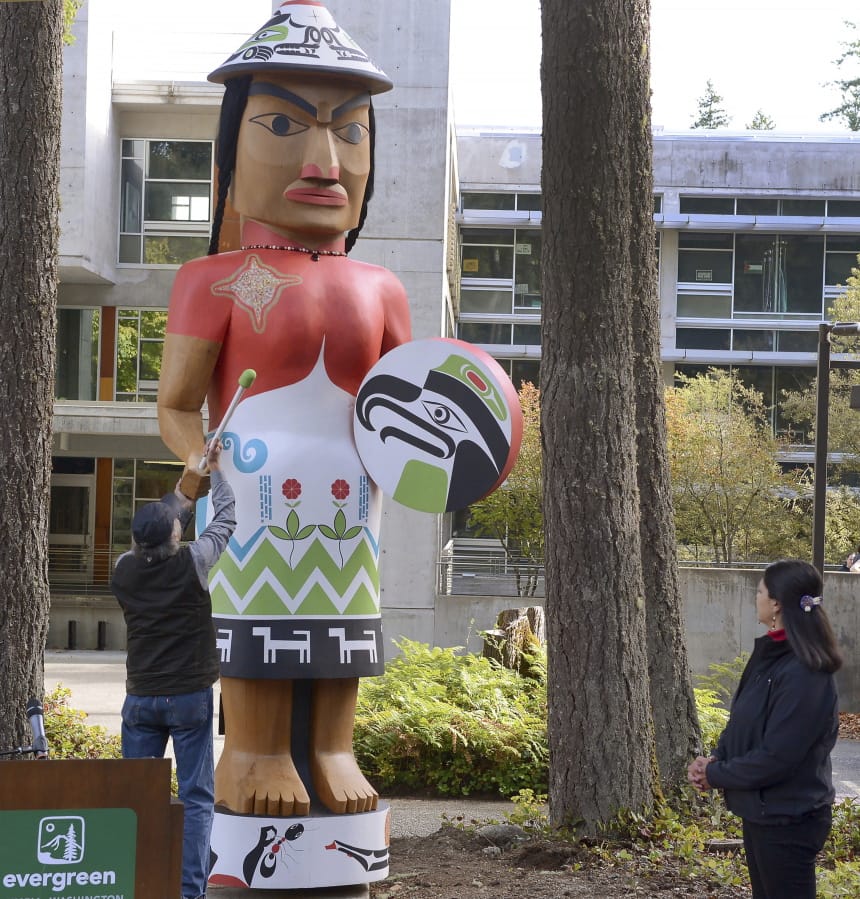OLYMPIA (AP) — As an undergraduate at The Evergreen State College in the 1970s, John Calambokidis took advantage of the university’s alternative approach.
He spent most of his time working independently or on group projects, and worked under two National Science Foundation grants. After graduating in 1978, he launched a research nonprofit called Cascadia Research.
“I was one of the students who benefited from the high degree of freedom that Evergreen encouraged,” Calambokidis said.
But that flexibility isn’t for everybody — and starting next semester, students will be able to choose from 11 “paths” that give them a clearer road to a career. Choosing a path isn’t required for graduation. But their creation marks a drastic change from the current structure, which gives students leeway to chart their own academic journey through an ever-changing set of courses and programs designed by faculty.
Officials acknowledge that the changes are meant to reverse a steep drop in enrollment. Evergreen’s enrollment began steadily declining in 2010, in line with a national trend of falling enrollment at liberal arts colleges. But deep unrest at Evergreen in 2017, when student protests erupted over a series of complex race-related issues, attracted negative national attention; Evergreen’s enrollment has since plummeted about 27%, to 2,854 students this fall from just over 3,900 students in 2017. The university is also trying other strategies, such as raising more money for scholarships and launching a new program for first-year students, The Olympian recently reported.
In 1967, then-Gov. Dan Evans and the state Legislature founded Evergreen, a public liberal arts college based in Olympia, as an experiment: Students don’t get grades and they don’t have majors. The college’s flexible curriculum has allowed faculty to plan their courses anew each year. If a significant political event happens, for instance, faculty can create a class dedicated to studying it.
The creation of formalized paths, college officials said, will make Evergreen’s offerings more predictable. Faculty will plan many courses and programs several years in advance so students can more easily map out their schedules.
The change, officials said, is a direct response to student attitudes about Evergreen. A recent student survey, for instance, found that some are satisfied with Evergreen’s structure. But several asked for additional independent study options, more information about future class offerings or better coordination within academic disciplines.
College leaders want the new paths, which are tied to careers in agriculture, the arts, science and politics, to send a message of renewal: that Evergreen is a serious academic institution and responsive to student opinions.
“It’s just a way of innovating yet again, which is the way we roll,” said Sandra Kaiser, Evergreen’s vice president of college relations.
The college’s course catalog will outline the paths so students can more easily visualize how courses fit together. Unlike majors, the paths don’t include a set of required courses or programs. And students aren’t required to “declare” a path.
The creation of more structured academic programs is a long time coming. Calambokidis said he remembers talk of a similar concept back in the 1970s. And some of the arts and sciences disciplines have long had a pathlike structure, said Laurie Meeker, who said she has worked at Evergreen since 1989 and teaches media studies and film production.
The paths formalize this and, “make what we do at Evergreen more coherent and visible,” she said.
More serious conversations about the paths began around 2016, said Krishna Chowdary, who teaches physics and math and is a former leader of a faculty governance committee on curriculum. A few years before, he said, the college conducted a study of students who had transferred out. According to Chowdary, many students said it wasn’t clear how Evergreen would help them achieve their goals.
“Because we were surveying students who had left the institution, it was a really powerful signal,” he said. One serious problem, he said: Students yearned to do advanced coursework but couldn’t figure out how to do it at Evergreen.
The new paths signal which courses are introductory, intermediate and advanced, said Elizabeth Williamson, who teaches English literature.
The Andrew W. Mellon Foundation, a New York-based philanthropic organization, awarded Evergreen a series of grants totaling $800,000 to launch the paths. The concept was incorporated into the faculty’s collective bargaining agreement in 2018.
Not everyone is enthusiastic, though. Michael Zimmerman, Evergreen’s provost from 2011 to 2016, sees the paths as moving away from the academic philosophy that makes the college unique. Evergreen has an “alternative model that needs to be sold if it’s going to be bought,” he said. Zimmerman no longer works at Evergreen; he told The Seattle Times university President George Bridges asked him to leave his post as provost.
“Good liberal arts education makes students career-ready, period,” he said. Creating paths and telling students “this prepares them for a particular kind of job, I think is misleading, counterproductive and antithetical to what a liberal arts education is supposed to be about.”
Next school year, college officials said they plan to add paths related to business, and psychology and social work, areas in which students expressed interest on recent surveys.



